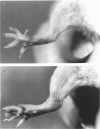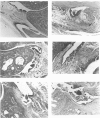Abstract
Adjuvant arthritis, induced by injections of Freund's complete adjuvant into the footpads of some rat strains, has been recognized as a useful animal model for many years. There has, however, been notable lack of success in reproducing this model in other species. We now describe the development of adjuvant arthritis in healthy strain mice approximately 2 months after injection of Freund's complete adjuvant. Although the clinical appearance of the mice and the joint histopathology closely resemble the adjuvant arthritis reported in the rat, we were unable to detect rheumatoid factor in sera from the affected animals. In parallel studies of T cell proliferation, affected animals responded to some mycobacterial antigens but not to the 65-kD heat shock protein of Mycobacterium tuberculosis, suggesting that some other epitope is important in the development of the disease.
Full text
PDF






Images in this article
Selected References
These references are in PubMed. This may not be the complete list of references from this article.
- Cremer M. A., Kang A. H. Collagen-induced arthritis in rodents: a review of immunity to type II collagen with emphasis on the importance of molecular conformation and structure. Int Rev Immunol. 1988 Sep;4(1):65–81. doi: 10.3109/08830188809044771. [DOI] [PubMed] [Google Scholar]
- Ellis J. S., Chain B. M., Cooke A., Ibrahim M. A., Katz D. R. Adjuvant composition determines the induction of type II collagen-induced arthritis. Scand J Immunol. 1992 Jul;36(1):49–56. doi: 10.1111/j.1365-3083.1992.tb02939.x. [DOI] [PubMed] [Google Scholar]
- Geiler V. G., Keitel W., Franke A. Vergleichende Histologie der Adjuvans-Arthritis bei Ratten, Mäusen und Hamstern. Allerg Immunol (Leipz) 1974 1975;20-21(2):251–252. [PubMed] [Google Scholar]
- Glenn E. M., Bowman B. J., Rohloff N. A., Seely R. J. A major contributory cause of arthritis in adjuvant-inoculated rats: granulocytes. Agents Actions. 1977 Jul;7(2):265–282. doi: 10.1007/BF01969985. [DOI] [PubMed] [Google Scholar]
- Isenberg D. A., Katz D., Le Page S., Knight B., Tucker L., Maddison P., Hutchings P., Watts R., André-Schwartz J., Schwartz R. S. Independent analysis of the 16/6 idiotype lupus model. A role for an environmental factor? J Immunol. 1991 Dec 15;147(12):4172–4177. [PubMed] [Google Scholar]
- Katz D. R., Feldmann M., Tees R., Schreier M. H. Heterogeneity of accessory cells interacting with T-helper clones. Immunology. 1986 Jun;58(2):167–172. [PMC free article] [PubMed] [Google Scholar]
- Klareskog L. What can we learn about rheumatoid arthritis from animal models? Springer Semin Immunopathol. 1989;11(3):315–333. doi: 10.1007/BF00197310. [DOI] [PubMed] [Google Scholar]
- Locniskar M., Zumla A., Mudd D. W., Isenberg D. A., Williams W., McAdam K. P. Human monoclonal antibodies to phenolic glycolipid-I derived from patients with leprosy, and production of specific anti-idiotypes. Immunology. 1988 Jun;64(2):245–251. [PMC free article] [PubMed] [Google Scholar]
- Mendlovic S., Brocke S., Shoenfeld Y., Ben-Bassat M., Meshorer A., Bakimer R., Mozes E. Induction of a systemic lupus erythematosus-like disease in mice by a common human anti-DNA idiotype. Proc Natl Acad Sci U S A. 1988 Apr;85(7):2260–2264. doi: 10.1073/pnas.85.7.2260. [DOI] [PMC free article] [PubMed] [Google Scholar]
- Nakamura R. M., Tanaka H., Tokunaga T. Strain difference in delayed-type hypersensitivity to BCG in mice: role of splenic adherent cells in the primary immune response. Immunology. 1982 Dec;47(4):729–731. [PMC free article] [PubMed] [Google Scholar]
- PEARSON C. M. Development of arthritis, periarthritis and periostitis in rats given adjuvants. Proc Soc Exp Biol Med. 1956 Jan;91(1):95–101. doi: 10.3181/00379727-91-22179. [DOI] [PubMed] [Google Scholar]
- Rook G., Thompson S., Buckley M., Elson C., Brealey R., Lambert C., White T., Rademacher T. The role of oil and agalactosyl IgG in the induction of arthritis in rodent models. Eur J Immunol. 1991 Apr;21(4):1027–1032. doi: 10.1002/eji.1830210425. [DOI] [PubMed] [Google Scholar]
- Watts R. A., Ravirajan C. T., Staines N. A., Isenberg D. A. A human fetal monoclonal DNA-binding antibody shares idiotypes with fetal and adult murine monoclonal DNA-binding antibodies. Immunology. 1990 Mar;69(3):348–354. [PMC free article] [PubMed] [Google Scholar]
- Wooley P. H. Animal models of rheumatoid arthritis. Curr Opin Rheumatol. 1991 Jun;3(3):407–420. doi: 10.1097/00002281-199106000-00013. [DOI] [PubMed] [Google Scholar]
- Young D., Lathigra R., Hendrix R., Sweetser D., Young R. A. Stress proteins are immune targets in leprosy and tuberculosis. Proc Natl Acad Sci U S A. 1988 Jun;85(12):4267–4270. doi: 10.1073/pnas.85.12.4267. [DOI] [PMC free article] [PubMed] [Google Scholar]





